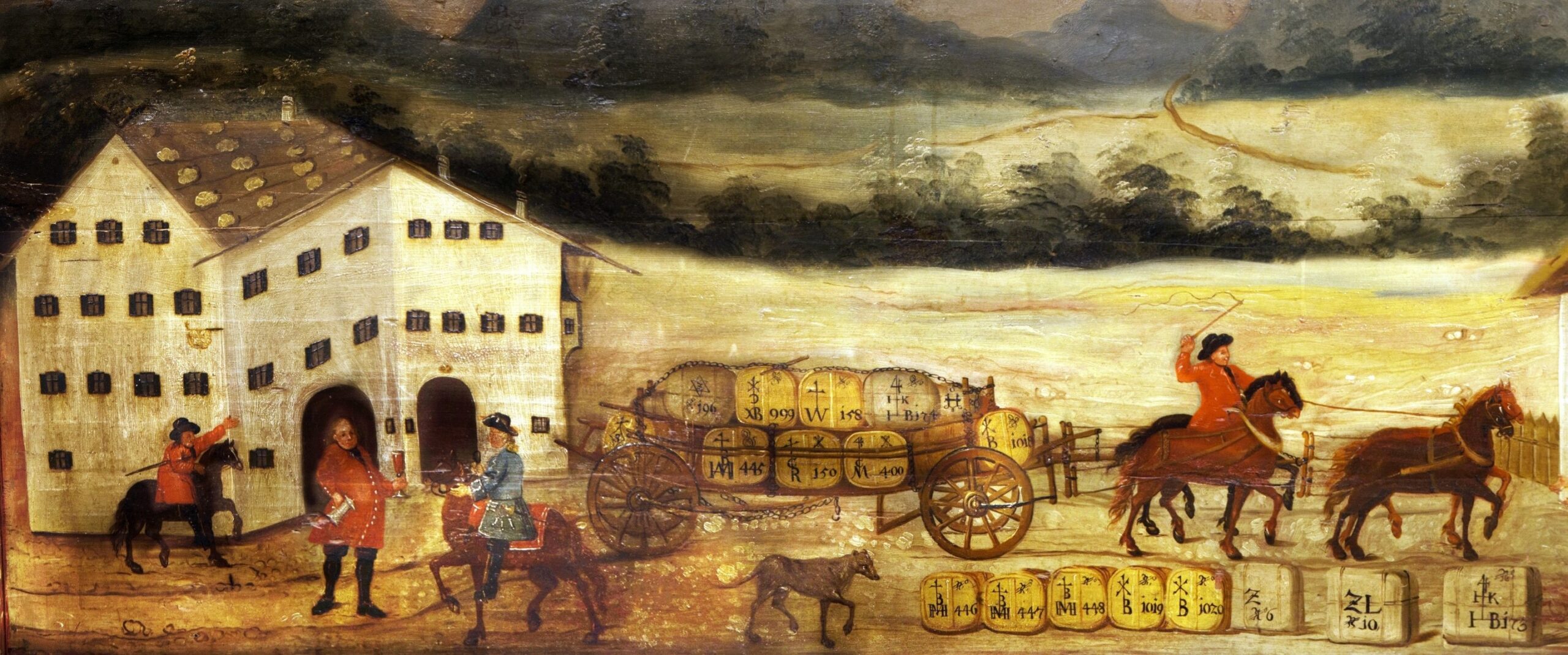Inns and Innkeepers: A Long-Term Perspective
Touriseum Trauttmansdorff, Meran | Merano 16–17 October 2025
Inns are an essential part of the tourist infrastructure. Nowadays, they are usually divided into res-taurants and hotels, offering guests food and drink, accommodation and much more. Advertising texts like to emphasise the quiet location and market the proximity to ski slopes, lifts or hiking trails. Promotional photographs try to create images to match. However, inns offering food and drink and overnight accommodation existed long before the Alps, and with them South Tyrol, became a popu-lar destination for summer visitors and mountaineers in the nineteenth century and later for tourists. Since the late Middle Ages, and increasingly since the sixteenth century, inns have fulfilled precisely this function.
The large number of inns documented for early modern South Tyrol, some of which still exist today, cannot be explained solely by the journeys south made by artists, scholars, pilgrims, diplomats and aristocrats. Rather, they were linked – again as an essential infrastructure – to the extremely lively trade, transport and transit of goods through Tyrol, which had been an important economic factor for centuries. Wherever horses were changed, goods loaded and unloaded, duties paid, routes of a certain length or mule tracks of a certain altitude, there were inns or at least hostels, concentrated in the central transit towns such as Klausen/Chiusa or Sterzing/Vipiteno, as well as on the numerous secondary routes over mountains and passes. Guests included carters and muleteers, travelling sales-men and peddlers, cattle and wine merchants, but also transcontinental traders, for example on their way to the fairs in Bolzano, or smugglers. Inns were a hub for regional payments and loans. Large inns in central locations, known in Tyrol as Wirtstafern, had a special legal status. Innkeepers could be entrusted with public administrative tasks, such as keeping registers of their guests. They were multi-active players, often serving as officials in towns, market towns and villages, as well as guardi-ans, witnesses, godfathers and godmothers. Inns along transit routes are notable not least for a par-ticular pattern of marriage: wives often came from innkeeper families and, in addition to their rele-vant socialisation, contacts and networks, brought considerable wealth into the marriage.
The aim of the workshop is to take a broad, multi-perspective approach to this long history, bringing it to the fore as it seems to have been largely forgotten. The plaques on old South Tyrolean inns, for example, tell of the families of early owners and prominent guests, but the historical significance of trade, transport and transit remains unmentioned and therefore invisible. Today, transport and transit do not have a positive connotation due to the traffic and environmental problems associated with them, but historically they were an important area of activity and source of income for many local people.
The workshop is a collaboration between Siglinde Clementi, Centre for Regional History (https://www.regionalgeschichte.it/de) and Margareth Lanzinger, PI of the ERC Advanced Grant ‘Agents of Logistics and Infrastructure in Eighteenth Century Alpine Transit Traffic’ – ALPINNKONNECT (https://alpinnkonnect.univie.ac.at/), Department of Economic and Social History, University of Vienna, and Touriseum Trauttmansdorff (https://www.trauttmansdorff.it/Touriseum/).
German Version
Gasthäuser und Gastwirt:innen:
Eine Langzeitperspektive
Touriseum Trauttmansdorff, Meran 16.–17. Oktober 2025
Gasthäuser sind ein essentieller Bestandteil der touristischen Infrastruktur. Heute meist ausdifferenziert in Restaurant und Hotel, bieten sie den Gästen Essen und Trinken, Übernachtungsmöglichkeiten und vieles andere mehr. Werbetexte betonen gerne die ruhige Lage und vermarkten die Nähe zu Skipisten, Aufstiegsanlagen oder Wanderwegen. Werbefotos sind bemüht, entsprechende Bilder zu erzeugen. Gasthäuser, die für das leibliche Wohl sorgen und Gäste über Nacht beherbergen, gibt es allerdings nicht erst, seitdem die Alpen und damit auch Südtirol im Lauf des 19. Jahrhunderts ein bevorzugtes Ziel für Sommerfrischler:innen und Alpinist:innen, für die ‚Fremden‘ und später für Tourist:innen wurden. Denn Gasthäuser erfüllten bereits seit dem Spätmittelalter und in zunehmendem Maß seit dem 16. Jahrhundert genau diese Versorgungsaufgaben.
Die große Anzahl von Gasthäusern, die für das frühneuzeitliche Südtirol dokumentiert sind und die zum Teil bis heute fortbestehen, lässt sich auch nicht allein mit den Reisen Richtung Süden von Künstlern, Gelehrten, Pilger:innen, Diplomaten und Adeligen erklären. Vielmehr standen sie – wiederum als essenzielle Infrastruktur – in Zusammenhang mit dem überaus regen Handel, mit dem Transport und dem Transit von Waren durch Tirol, der über die Jahrhunderte einen bedeutenden Wirtschaftsfaktor darstellte. Überall dort, wo Pferde gewechselt, Waren auf- und abgeladen wurden, Zoll zu bezahlen war, Wegstrecken eine gewisse Länge oder Saumpfade eine gewisse Höhe erreichten, standen Wirtshäuser oder zumindest ein Hospiz, verdichtet in den zentralen Durchzugsorten wie Klausen oder Sterzing, aber auch auf den zahlreichen Nebenrouten über Berge und Pässe. Zu Gast waren Fuhrleute und Säumer, Wanderhändler:innen und Hausierer:innen, Vieh- und Weinhändler, aber auch transkontinental agierende Kaufleute, unterwegs etwa zu den Bozner Messen, oder Schmuggler:innen. Gasthäuser waren Drehscheibe für den regionalen Zahlungsverkehr und für Kredite. Große Gasthäuser an zentralen Orten, in Tirol „Wirtstafern“ genannt, hatten einen bestimmten Rechtsstatus. Gastwirte konnten mit öffentlichen Verwaltungsagenden betraut sein, etwa wenn sie Melderegister führen mussten. Sie waren pluriaktive Player und fungierten vielfach als Amtsträger in Städten, Märkten und Gerichten und auch als Vormünder und Zeugen, Gastwirte und Gastwirtinnen als Paten und Patinnen. Gastwirt:innen an Transitrouten fallen nicht zuletzt durch ein Heiratsmuster auf: Die Frauen kamen vielfach und großräumiger aus Gastwirtsfamilien und brachten neben ihrer einschlägigen Sozialisation, ihren Kontakten und Netzwerken, auch beträchtliches Vermögen mit in die Ehe.
Ziel des Workshops ist es, diese lange Geschichte im alpinen Raum und darüber hinaus in einer breiten multiperspektivischen Herangehensweise zu beleuchten und sie damit in den Vordergrund zu rücken, denn sie scheint weitgehend vergessen. Auf den an alten Gasthäuern angebrachten Infotafeln wird auf frühe Besitzerfamilien und prominente Gäste verwiesen, die historische Bedeutung von Handel, Transport und Transit bleibt jedoch unerwähnt und damit unsichtbar. Aktuell sind Transport und Transit wegen der damit verbundenen Verkehrs- und Umweltproblematiken nicht positiv konnotiert, historisch boten sie ein wichtiges Tätigkeitsfeld und eine Einnahmequelle für viele vor Ort.
Der Workshop findet in Kooperation zwischen Siglinde Clementi, Zentrum für Regionalgeschichte (https://www.regionalgeschichte.it/de), und Margareth Lanzinger, PI des ERC Advanced Grant „Agents of Logistics and Infrastructure in Eighteenth Century Alpine Transit Traffic“ – ALPINNKONNECT statt (https://alpinnkonnect.univie.ac.at/), Institut für Wirtschafts- und Sozialgeschichte, Universität Wien, und dem Touriseum Trauttmansdorff (https://www.trauttmansdorff.it/Touri-seum/) statt.
Italian Version
Locande, osti e ostesse: una prospettiva di lunga durata
Touriseum Trauttmansdorff, Merano 16-17 ottobre 2025
Le locande sono una parte integrante dell’infrastruttura turistica. Oggi solitamente si distinguono in ristoranti e hotel, che offrono agli ospiti una vasta gamma di servizi, quali cibo e bevande, alloggio e molto altro. Nei testi pubblicitari si sottolinea la posizione tranquilla e la vicinanza alle piste da sci, agli impianti di risalita o ai sentieri escursionistici. Le foto pubblicitarie cercano di creare immagini corrispondenti. Tuttavia, le locande che offrono servizi per il benessere fisico e di pernottamento non esistono solo da quando le Alpi, e quindi l’Alto Adige, sono diventate una meta privilegiata per i visi-tatori estivi e gli alpinisti, per i “forestieri” e poi per i turisti nel corso del XIX secolo. Del resto, le lo-cande svolgevano già queste funzioni di approvvigionamento nel tardo Medioevo e in misura cre-scente dal XVI secolo.
Il gran numero di locande documentate per l’Alto Adige della prima età moderna, alcune delle quali ancora oggi esistenti, non può essere spiegato solo con il flusso di artisti, studiosi, pellegrini, diploma-tici e aristocratici diretti a sud. Piuttosto, erano legate al vivacissimo commercio, al trasporto e al transito di merci attraverso il Tirolo, che rappresentarono un importante fattore economico nel corso dei secoli. Nei luoghi in cui si cambiavano i cavalli, si caricavano e scaricavano le merci e si pagavano i dazi, se i percorsi raggiungevano una certa lunghezza o le mulattiere una certa altezza, c’erano lo-cande o almeno un ospizio, concentrati nelle città centrali di transito come Chiusa o Vipiteno, ma an-che lungo i numerosi percorsi secondari attraverso montagne e passi. Tra gli ospiti c’erano carrettieri e cavalieri, commercianti ambulanti, mercanti di bestiame e di vino, ma anche mercanti transconti-nentali diretti alle fiere di Bolzano e contrabbandieri. Le locande erano i punti di riferimento per i pa-gamenti e i prestiti a livello regionale. Le grandi locande in posizione centrale, chiamate in Tirolo “Wirtstafern”, avevano un certo status giuridico. I locandieri potevano essere incaricati di compiti amministrativi pubblici, come la tenuta dei registri degli ospiti. Erano figure polivalenti e spesso rico-privano ruoli di funzionari nelle città, nei borghi e nelle aree rurali, oltre che da tutori e testimoni, pa-drini e madrine. I locandieri lungo le vie di transito si distinguevano non da ultimo per le loro abitu-dini matrimoniali: in molti casi, le donne provenivano da famiglie di locandieri e, oltre alla loro socia-lizzazione, ai loro contatti e alle loro reti, portavano in dote una notevole ricchezza.
L’obiettivo del workshop è far luce su questa lunga storia con un ampio approccio multiprospettico e riportarla alla ribalta, visto che sembra essere stata in gran parte dimenticata. Le tavole informative allegate alle vecchie locande altoatesine per esempio fanno riferimento alle prime famiglie proprieta-rie e agli ospiti di spicco, ma l’importanza storica del commercio, del trasporto e del transito non viene menzionata e quindi rimane invisibile. Attualmente, i trasporti e il transito non hanno una con-notazione positiva a causa dei problemi di traffico e ambientali ad essi associati, ma storicamente erano un’importante fonte di attività e di reddito per molti abitanti del luogo.
Il workshop è organizzato da Siglinde Clementi del Centro di Storia regionale (https://www.regional-geschichte.it/de), da Margareth Lanzinger del progetto di ricerca dell’ERC Advanced Grant “Agents of Logistics and Infrastructure in Eighteenth Century Alpine Transit Traffic” – ALPINNKONNECT (https://alpinnkonnect.univie.ac.at/), Dipartimento di Storia Economica e Sociale dell’Università di Vienna e il Touriseum Trauttmansdorff (https://www.trauttmansdorff.it/Touriseum/).



